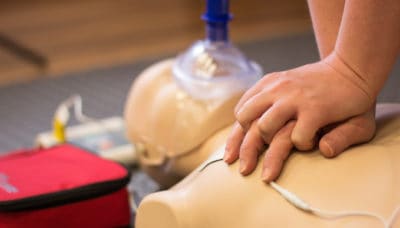Introduction
In today's fast-paced work environment, security is critical. Organizations are significantly identifying the value of creating a safe area for staff members. One of one of the most crucial elements of work environment safety training is initial aid and mouth-to-mouth resuscitation (Cardiopulmonary Resuscitation) programs. These training courses not only equip workers with crucial First Aid Courses Near Me life-saving skills yet also foster a society of safety and security within the organization. In this article, we will certainly look into the myriad reasons workplace security training must include emergency treatment and mouth-to-mouth resuscitation programs, highlighting their significance in improving office safety.
Why Office Safety Training Ought To Consist Of Emergency Treatment and Mouth-to-mouth Resuscitation Courses
The combination of emergency treatment and mouth-to-mouth resuscitation training courses into office safety training has far-ranging advantages. They furnish workers with the expertise and skills necessary to react effectively to clinical emergency situations, reduce recuperation time for damaged individuals, and possibly save lives. Furthermore, having educated personnel on-site can impart confidence among workers and guarantee them that their well-being is prioritized.

Understanding Initial Aid
First aid refers to the immediate treatment provided to an individual struggling with a minor or significant illness or injury till expert clinical assistance shows up. Recognizing basic first aid concepts can make a substantial difference in emergency situations.
Key Elements of First Aid
Assessment: The capacity to analyze a circumstance quickly can help establish the suitable actions needed. Stabilization: Comprehending exactly how to support a hurt person avoids further harm. Communication: Efficiently communicating with emergency situation solutions is critical for prompt assistance.The Relevance of CPR
CPR is a life-saving method utilized in emergency situations when somebody's heartbeat or breathing has quit. It includes chest compressions and rescue breaths to preserve blood flow and oxygenation up until expert aid arrives.
How CPR Works
- Chest Compressions: These assist distribute blood throughout the body. Rescue Breaths: These offer oxygen to the lungs.
Benefits of First Aid and CPR Certification
Obtaining a first aid certification or completing CPR courses features various benefits, both for people and organizations.
Enhanced Staff member Confidence: Workers feel extra protected understanding they possess life-saving skills. Reduced Healing Time: Quick feedback with emergency treatment can lead to much better results for damaged individuals. Compliance with Regulations: Several markets require licensed employees as component of their health and safety regulations.
Creating a Society of Safety And Security With Training
Implementing emergency treatment and CPR training cultivates a culture that prioritizes worker health.
Encouraging Teamwork
Training sessions commonly involve team-building exercises that improve cooperation among employees.
Building Trust Between Staff members and Management
When management buys worker training, it shows dedication to their wellness, leading to increased morale.
First Aid Rushes vs. Mouth-to-mouth Resuscitation Courses: What's the Difference?
While both click here kinds of training courses are crucial, they concentrate on various ability sets.
First Aid Courses
These programs cover a wide variety of subjects beyond simply heart emergencies, including:
- Wound care Burns Choking
CPR Courses
CPR training courses specifically concentrate on techniques connected to heart attack scenarios, emphasizing:
- Adult CPR Child/ infant resuscitation Use of an Automated External Defibrillator (AED)
Choosing the Right Training Provider
Not all training carriers are developed equal; consequently, picking one that meets your organization's requirements is critical.
Accreditation Matters
Ensure that your picked supplier offers approved courses acknowledged by pertinent authorities.
Instructor Experience
Consider teachers' credentials; seasoned instructors often supply richer learning experiences through real-world examples.
Incorporating Emergency treatment into Work Environment Security Policies
Organizations must integrate emergency treatment needs into their more comprehensive security policies for extensive coverage.
Regular Training Updates
Conducting regular refresher courses ensures that knowledge remains current amongst employees.
Creating Emergency Response Plans
Having clear strategies in position can guide qualified employees throughout emergencies.

Legal Effects of First Aid Training in the Workplace
Employers have lawful responsibilities pertaining CPR courses I can attend to workplace safety; applying first aid training can aid reduce risks related to non-compliance.
Negligence Claims
Failure to offer sufficient training might leave companies prone to suits if an event occurs because of lack of preparedness.
FAQ Section
What is included in a regular emergency treatment course?- A common emergency treatment course includes guideline on evaluating injuries, treating wounds, taking care of burns, managing choking events, and doing mouth-to-mouth resuscitation if necessary.
- Most mouth-to-mouth resuscitation courses last in between 4-- 6 hours relying on whether it's basic or advanced training.
- While not always lawfully mandated, having accredited personnel can considerably enhance office security standards.
- Many recognized companies use on-line revival options for first aid certificates which include assessments via video clip conferencing.
- Yes, sectors such as construction, medical care, education, and production typically have regulatory needs requiring experienced workers on site.
- It's advised that employees participate in refresher courses every 2 years or earlier if there are considerable modifications in treatments or regulations.
Conclusion
To summarize, integrating first aid and CPR into office safety training is not merely an option however a requirement in today's workplace where emergency situations can occur at any moment. Organizations advantage exceptionally from having trained personnel all set to react effectively throughout crises while fostering an ambience where worker wellness takes precedence over all else. Therefore, it ends up being obvious why work environment security training must consist of first aid and mouth-to-mouth resuscitation courses-- they save lives while promoting a proactive technique towards health and safety requirements within companies throughout various sectors.

By focusing on such necessary training initiatives-- first aid certifications acquired via reputable suppliers alongside useful hands-on experience-- companies can dramatically improve their general emergency readiness levels while additionally developing stronger groups efficient in taking on any type of scenario head-on!